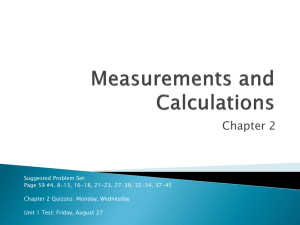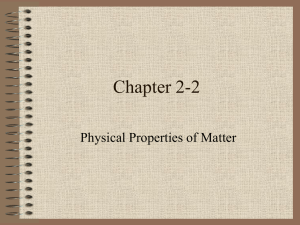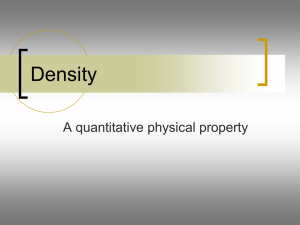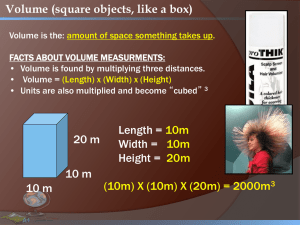matter2012october - John Bowne High School
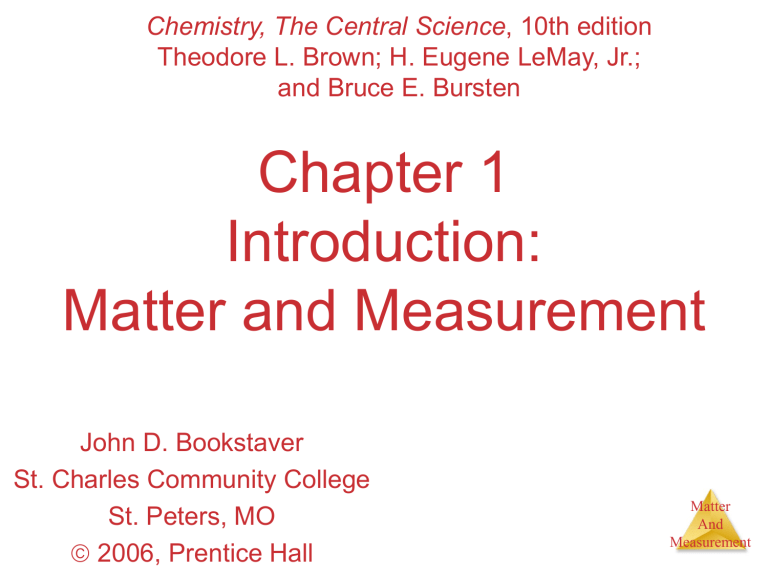
Chemistry, The Central Science , 10th edition
Theodore L. Brown; H. Eugene LeMay, Jr.; and Bruce E. Bursten
Chapter 1
Introduction:
Matter and Measurement
John D. Bookstaver
St. Charles Community College
St. Peters, MO
2006, Prentice Hall
Matter
And
Measurement
Matter:
Anything that has mass and takes up space.
Matter
And
Measurement
Properties and
Changes of
Matter
Matter
And
Measurement
Properties of Matter
• Physical Properties:
□ Can be observed without changing a substance into another substance.
• Boiling point, density, mass, volume, etc.
• Chemical Properties:
□ Can only be observed when a substance is changed into another substance.
• Flammability, corrosiveness, reactivity with acid, etc.
Matter
And
Measurement
Properties of Matter
• Intensive Properties:
□ Independent of the amount of the substance that is present.
• Density, boiling point, color, etc.
• Extensive Properties:
□ Dependent upon the amount of the substance present.
• Mass, volume, energy, etc.
Matter
And
Measurement
Changes of Matter
• Physical Changes:
□ Changes in matter that do not change the composition of a substance.
• Changes of state, temperature, volume, etc.
• Chemical Changes:
□ Changes that result in new substances.
• Combustion, oxidation, decomposition, etc.
Matter
And
Measurement
Chemical Reactions
In the course of a chemical reaction, the reacting substances are converted to new substances.
Matter
And
Measurement
Units of
Measurement
Matter
And
Measurement
SI Units
• There are two types of units:
– fundamental (or base) units;
– derived units.
• There are 7 base units in the SI system.
Matter
And
Measurement
SI Units
• Système International d’Unités
• Uses a different base unit for each quantity
Matter
And
Measurement
Metric System
Prefixes convert the base units into units that are appropriate for the item being measured.
Matter
And
Measurement
Volume
• The units for volume are given by (units of length) 3 .
– SI unit for volume is 1 m 3 .
• We usually use 1 mL = 1 cm 3 .
• Other volume units:
– 1 L = 1 dm 3 = 1000 cm 3
= 1000 mL.
Matter
And
Measurement
Uncertainty in Measurements
Different measuring devices have different uses and different degrees of accuracy.
Matter
And
Measurement
Density:
Physical property of a substance d = m
V
Matter
And
Measurement
Do now: A graduated cylinder is filled with 15.0 mL of water. An object with a mass of 29.66 g causes the total volume to increase to 23.4 mL.
What is the density of the sample?
Matter
And
Measurement
Vocabulary review
• Mass : amount of matter in an object.
• It is measured with a balance.
• Unit in the SI system: grams g
• Weight: a measure of the pull that the gravity exerts over an object.
• If we stay in the same planet (same gravity) is used like the mass.
Matter
And
Measurement
Volume
• The space that an object occupies.
• Unit of volume in SI Liter = L
Matter
And
Measurement
What is density?
• Density is a comparison of how much matter there is in a certain amount of space.
• IT IS AN INTENSIVE PHYSICAL
PROPERTY. It is used to identify a substance.
Matter
And
Measurement
DENSITY OF WATER
• 1g/ml
• That means that a gram of water has a volume of 1 milliliter or 1 cubic centimeter.
Matter
And
Measurement
Which one is more dense?
• Now which one is more dense?
Matter
And
Measurement
What is density?
• Density = mass volume or
• mass ÷ volume.
Units for density: g cm 3
• Why are these the units for density?
ALWAYS
REMEMBER
UNITS!
.
Matter
And
Measurement
Let’s try a density problem together
• Find the density of a yellow rock has a mass of 8 g and a volume of 4 cm 3.
• Use your table S to determine what element it could be!
Matter
And
Measurement
IMMISCIBLE LIQUIDS
• If you pour together liquids that don’t mix and have different densities, they will form liquid layers.
• Liquids that don’t mix are said to be
IMMISCIBLE
• The liquid with the highest density will be on the bottom .
• The liquid with the lowest density will be on the top .
Matter
And
Measurement
Liquid Layers
• . Which layer has the highest density?
• Which layer has the lowest density?
• Imagine that the liquids have the following densities:
– 10g/cm 3 .
– 6g/cm 3 .
3g/cm 3 .
5g/cm 3 .
• Which number would go with which layer?
• Is any of the liquids water?
Matter
And
Measurement
To measure the volume of an object
• If is a regular object measure the dimensions needed and use the formula
• cube= LxWxH
• Cylinder = p h r 2
• For an irregular object use the water displacement method.
Matter
And
Measurement
Liquid Layers – Try with your neighbor
• Which liquid has the highest density?
• Which liquid has the lowest density?
• Which liquid has the middle density?
Matter
And
Measurement
Liquid Layers – Try on your own!
• Imagine that the liquids on the right have the following densities:
– 15g/cm 3 10g/cm 3
– 3g/cm 3 9g/cm 3
– 7g/cm 3 12g/cm 3
• Match the colors to the correct densities.
3g/cm 3
9g/cm 3
12g/cm 3
7g/cm 3
10g/cm 3
15g/c
Matter m 3
And
Measurement
Review
• What is the formula for density?
• What happens if you pour together liquids that have different densities?
• Will the liquid on the top have the highest or lowest density?
• Will the liquid on the bottom have the highest or lowest density?
Matter
And
Measurement
Density worksheet answers
• 1=1
• 2=2
• 3=2 D of Na 0.971 g/mL
• 4=4 D of Mg 1.738 g/cm3
• 5=2
• 6 20g/24.4L = 0.82 g/L
Matter
And
Measurement
• HOMOGENEOUS : SAME
PROPERTIES THROUGHOUT THE
SAMPLE
• HETEROGENEOUS :
• DIFFERENT PROPERTIES IN
DIFFERENT PARTS OF THE SAMPLE
Matter
And
Measurement
PURE SUBSTANCES have a constant composition
• ELEMENTS – Made up of same kind of atoms. Could not be decomposed.
• COMPOUNDS – Made up of different kind of atoms CHEMICALLY
COMBINED. Can be decomposed.
• Recognizable by formulas!
Matter
And
Measurement
Mixtures and Compounds
Matter
And
Measurement
Compounds
Compounds can be broken down into more elemental particles.
Matter
And
Measurement
Matter
• Atoms are the building blocks of matter.
Matter
And
Measurement
Matter
• Atoms are the building blocks of matter.
• Each element is made of the same kind of atom.
Matter
And
Measurement
Matter
• Atoms are the building blocks of matter.
• Each element is made of the same kind of atom.
• A compound is made of two or more different kinds of elements.
Matter
And
Measurement
SEPTEMBER 21
• ELEMENT , COMPOUNDS AND
MIXTURES
• REVIEW FOR TEST
• PHYSICAL AND CHEMICAL
PROPERTIES
• PHYSICAL AND CHEMICAL
CHANGES
• DENSITY
Matter
And
Measurement
MIXTURES
• Combination of two or more pure substances. Can be separated by physical means. They do not have a fixed composition.
• Can be homogeneous or heterogeneous.
• SOLUTIONS ARE HOMOGENEOUS
MIXTURES.
Matter
And
Measurement
AQUEOUS SOLUTIONS
The solution is prepared using water as the solvent
(aq) means DISSOLVED IN WATER!!!
Na Cl (s) is a compound
Na Cl (aq) is a mixture!!!!
Matter
And
Measurement
Pure
Substances and Mixtures
Matter
And
Measurement
Pure Substances and Mixtures
• If matter is not uniform throughout, then it is a heterogeneous mixture .
• If matter is uniform throughout, it is homogeneous .
• If homogeneous matter can be separated by physical means, then the matter is a mixture.
• If homogeneous matter cannot be separated by physical means, then the matter is a pure substance .
• If a pure substance can be decomposed into something else, then the substance is a compound .
Matter
And
Measurement
Elements
• If a pure substance cannot be decomposed into something else, then the substance is an element .
• There are 114 elements known.
• Each element is given a unique chemical symbol
(one or two letters).
• Elements are building blocks of matter.
• The earth’s crust consists of 5 main elements. (O,
Si, Al, Fe, Ca)
• The human body consists mostly of 3 main elements. (O, C, H)
Matter
And
Measurement
Elements
Matter
And
Measurement
Metals, Nonmetals, and Metalloids
Matter
And
Measurement
Symbols
• First letter of element in CAPITAL letter
• Second or third letter in lower case.
• Some elements have symbols different from the english name
• SODIUM Na
• POTASSIUM K
• CUPPER Cu
• LEAD Pb
Matter
And
Measurement
• IRON Fe
• MERCURY Hg
• GOLD Au
• SILVER Ag
• TIN Sn
Matter
And
Measurement
Symbols from Latin Names
Element
Copper
Gold
Lead
Mercury
Potassium
Silver
Sodium
Tin
Hg
K
Ag
Na
Sn
Symbol
Cu
Au
Pb
Latin name cuprum aurum plumbum hydrargyrum kalium argentum natrium stannum
Matter
And
Measurement
DIATOMIC ELEMENTS
•H
2
O
2
F
2
Br
2
I
2
N
2
Cl
2
Matter
And
Measurement
Matter
And
Measurement
Classification of Matter
Matter
And
Measurement
Classification of Matter
Matter
And
Measurement
Classification of Matter
Matter
And
Measurement
Classification of Matter
Matter
And
Measurement
Classification of Matter
Matter
And
Measurement
Classification of Matter
Matter
And
Measurement
Classification of Matter
Matter
And
Measurement
Classification of Matter
Matter
And
Measurement
Classification of Matter
Matter
And
Measurement
Classification of Matter
Matter
And
Measurement
• 1 . A
• 2 . A
• 3. A
• 4. D
• 5. A
• 6. B
• 7. C
• 8. D
• 9. D
MC ANSWERS
Matter
And
Measurement
Chemical Reactions
Matter
And
Measurement
Electrolysis of Water
Matter
And
Measurement
Separation of
Mixtures
Matter
And
Measurement
Distillation:
Separates homogeneous mixture on the basis of differences in boiling point.
Matter
And
Measurement
Distillation
Matter
And
Measurement
Filtration:
Separates solid substances from liquids and solutions.
Matter
And
Measurement
Chromatography:
Separates substances on the basis of differences in solubility in a solvent.
Matter
And
Measurement
Uncertainty in
Measurement
Matter
And
Measurement
Significant Figures
• The term significant figures refers to digits that were measured.
• When rounding calculated numbers, we pay attention to significant figures so we do not overstate the accuracy of our answers.
Matter
And
Measurement
Uncertainty in Measurement
• All scientific measures are subject to error.
• These errors are reflected in the number of figures reported for the measurement.
Precision and Accuracy
• Measurements that are close to the “correct” value are accurate .
• Measurements that are close to each other are precise .
Matter
And
Measurement
• ACCURACY
DEALS WITH THE
EXACTESNESS OF
THE
MEASUREMENT,
HOW CLOSE IT IS
TO THE , TRUE,
ACCEPTED OR
STANDARD
VALUE
• PRECISSION
DEALS WITH
REPRODUCIBILITY
OF A
MEASUREMENT.
• IF SEVERAL
MEASUREMENTS
GIVE A SIMILAR
RESULT IT IS SAID
THAT THE
MEASUREMENT IS
Matter
PRECISE And
Measurement
Accuracy versus Precision
• Accuracy refers to the proximity of a measurement to the true value of a quantity.
• Precision refers to the proximity of several measurements to each other.
Matter
And
Measurement
October 5
• UNCERTAINTY IN MEASUREMENT
• SIGNIFICANT FIGURES – Rules and examples
• DO NOW
• Calculate the density of an object that has a mass of 10.0 g and a volume of
3.0 mL.
Matter
And
Measurement
Measuring Volume by water displacement
Matter
And
Measurement
Significant Figures
• The number of digits reported in a measurement reflect the accuracy of the measurement and the precision of the measuring device.
• All the figures known with certainty plus one extra figure (estimated digit) are called significant figures.
Matter
And
Measurement
Sig fig in calculations
• In any calculation, the results are reported to the fewest significant figures
(for multiplication and division) or fewest decimal places (addition and subtraction).
Matter
And
Measurement
Significant Figures
1. All nonzero digits are significant.
2. Zeroes between two significant figures are themselves significant.
3. Zeroes at the beginning of a number are never significant.
4. Zeroes at the end of a number are significant if a decimal point is written in the number or if they are to the right of a decimal point.
Matter
And
Measurement
0.0030 has 2 sf
400.
Has 3 sf
700.00 has 5 sf
Matter
And
Measurement
EXAMPLE FOR ADDITION
• Copy and perform the following operation indicating the right number of sig fig
12
1.2
0.2
---------------------
Matter
And
Measurement
MULTIPLICATION AND
DIVISION
5 x 100 =
0.00022 x 745 =
3469/ 5799=
Matter
And
Measurement
Examples: How many significant figures are in each of the following?
1. 52300 m
2. 0.000487 kg
3. 29.0400 s
4. 507 people
5. 230,050 cm
6. 45.600 A
Matter
And
Measurement
Tell the number of significant digits in each of the following measurements.
1. 48 cm __________
2. 306.2 g __________
3. 0.329 m __________
4. 83.9520 ° C __________
5. 3700 mm __________
6. 400. cm 3 __________
7. 71.60 g __________
8. 0.00432 mm __________
9. 10.0 kg __________
10. 3.60 × 10 15 sec __________
11. 6.24 × 10 -4 m __________
12. 82.000 g __________
Matter
And
Measurement
Tell the number of significant digits in each of the following measurements.
1. 48 cm __________
2. 306.2 g __________
3. 0.329 m __________
4. 83.9520 ° C __________
5. 3700 mm __________
6. 400. cm 3 __________
7. 71.60 g __________
8. 0.00432 mm __________
9. 10.0 kg __________
10. 3.60 × 10 15 sec __________
11. 6.24 × 10 -4 m __________
12. 82.000 g __________
Matter
And
Measurement
• How do scientist express the accuracy of a measurement?
• DO NOW : Observe the two instruments in my desk to measure volume, determine which would determine the volume of an Al cylinder with greater accuracy and explain in your notebook why.
Matter
And
Measurement
Percent Error
• To determine the accuracy of a measurement. It tells us how far our measured stands from an accepted or known value.
% error = I measured value – accepted value I X 100
___________________________________________ accepted value
Matter
And
Measurement
Example
• Calculate the percent error of the measurement for a student that determined that the density for Al is 2.5 g/mL. Hint use table T to determine the accepted value!
Matter
And
Measurement
1) 3.482 cm + 8.51 cm + 16.324 cm ____________________
2) 48.0032 g + 9.17 g + 65.4321 g ____________________
3) 80.4 cm - 16.532 cm ____________________
4) 106.5mL - 30. mL ____________________
5) 48.2 cm × 1.6 cm × 2.12 cm ____________________
6) 8.3 m × 4.0 m × 0.9823 m
Matter
And
Measurement
7) 64.34 cm3 ÷ 8.149 cm ____________________
8) 4.93 mm2 ÷ 18.71 mm ____________________
9) 0 57 mL x 760 mm/740 mm x 273K/250 K
10) 5 13 g x 44 962amu/15 874 a m u
Matter
And
Measurement
1. 28.32 cm
2. 122.61 g
3. 63.9 cm
4. 76 mL
5. 160 cm 3
6. 33 m 3
7. 7.895 cm 2
8. 0.263 mm
Answers
Matter
And
Measurement
1. 3
2. 2
3. 3
4. 2
5. 1
6. 1
7. 4
8. 1
MULTIPLE CHOICE
Matter
And
Measurement
• 1. According to an accepted chemistry reference. the heat of vaporization of water is
540. calories per gram. A student determined in the laboratory that the heat of vaporization of water was 620. calories per gram. The student's results had a percent error of (1)
12.9, (2) 80.0, (3) 14.8, (4) 87.1
• 2. Which measurement contains a total of three significant figures?
• (1) 0.01 g (2) 0.0100 g (3) 0.010 g (4)
0.01000 g
Matter
And
Measurement
3. In an experiment the gram atomic mass of magnesium was determined to be 24.7. Compared to the accepted value
24.3, the percent error for this determination was (1) 0. 400,
(2) 24.7, (3) 1.65, (4) 98.4
4. A student determined the melting point of a substance to be 55.2
° C. If the accepted value is 50. 1 ° C the percent error in her determination is (1) 5.10, (2) 10.2, (3) 9.24, (4)
12.0
5. Using the rules for significant figures, the sum of 0. 027 gram and 0. 0023 gram should be expressed as (1) 0. 029 gram, (2) 0.03 gram, (3) 0.0293 gram, (4) 0.030 gram
Matter
And
Measurement
6. Which milligram quantity contains a total of four significant figures? (1) 0.3010 mg (2) 3100 mg (2) 3010 mg (4) 30001 mg
Matter
And
Measurement
Scientific Notation
•Numbers written in scientific notation include a numeral with one digit before the decimal point, multiplied by some power of ten (6.022 x 10 23 )
•In scientific notation, all digits are significant.
•You should be able to convert from non-scientific notation to scientific and vice-versa.
Matter
And
Measurement
• Temperature
• Definition
• Instrument
• Scales
Matter
And
Measurement
TEMPERATURE
• Is associated with heat but it is NOT
HEAT. IT IS NOT A FORM OF
ENERGY!!!! ( Heat is)
• Review: What is KINETIC ENERGY?
Matter
And
Measurement
KINETIC ENERGY (KE)
• Is associated with movement.
• If an object is moving fast has high KE
• If an object is moving slowly it has low KE
Matter
And
Measurement
Temperature
• In scientific measurements, the
Celsius and Kelvin scales are most often used.
• The Celsius scale is based on the properties of water.
□ 0
C is the freezing point of water.
□ 100
C is the boiling point of water.
Matter
And
Measurement
Temperature:
A measure of the average kinetic energy of the particles in a sample
.
If an object is at HIGH temperature its particles are moving FAST
At LOW temperature particles move SLOWLY
Matter
And
Measurement
Instrument to measure temperature
THERMOMETER
Matter
And
Measurement
FIXED POINTS OF A
THERMOMETER
• BOILING POINT OF WATER
• FREEZING POINT OF WATER
Matter
And
Measurement
Temperature
• The Kelvin is the SI unit of temperature.
• It is based on the properties of gases.
• There are no negative Kelvin temperatures.
• K =
C + 273.15
Matter
And
Measurement
Temperature
• The Fahrenheit scale is not used in scientific measurements.
•
F = 9/5(
C) + 32
•
C = 5/9(
F − 32)
Matter
And
Measurement
Examples:
1. What is 35ºC in Kelvin? In ºF?
2. What is 183 K in ºC? In ºF?
Matter
And
Measurement


